Western Digital WD740ADFD: Bottled Lightning
by Gary Key on February 7, 2007 3:30 AM EST- Posted in
- Storage
iPeak Business Application Tests
Our iPeak Winstone benchmarks offer a glimpse into how well our hard disk drives will handle general office applications, media encoding, and graphics manipulation. While the business applications that are being tested tend to be more CPU bound at times, the performance of the hard drive can and will make a difference in the more disk intensive video and graphics applications where large media files are typically being edited.
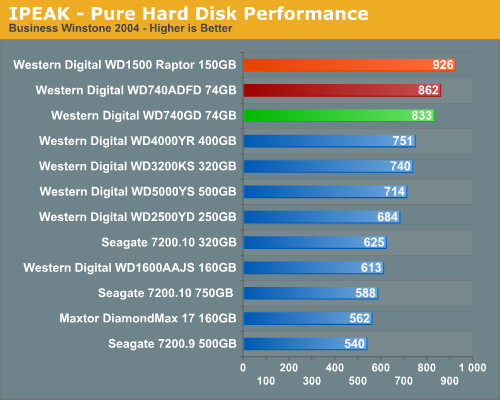
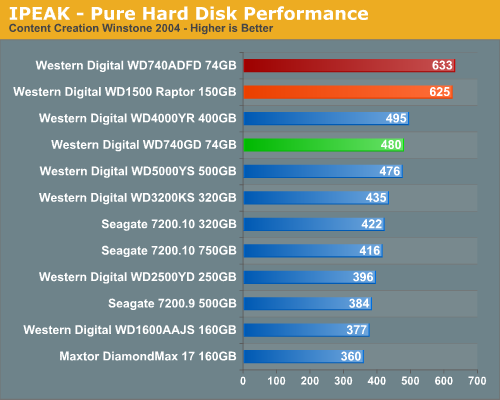
As expected the WD Raptor drives finish at the top in our business application tests as their 10k RPM spindle speed and optimized cache play an important role in their ability to sustain high transfer rates, especially in the Content Creation benchmark where transfer block sizes are significantly larger and more random than in the Business application benchmark. We see our WD74ADFD finishing ahead of the WD1500ADFD in the Content Creation benchmark where write operations account for a large portion of the test and just barely trailing in the Business Winstone test that emphasizes small block sizes of data in non-sequential order.
iPeak General Task Tests
The iPeak based General Task benchmarks are designed to replicate utility based application tasks that typically are disk intensive and represent common programs utilized on the majority of personal computers. While the WinRAR program is very CPU intensive it will typically stress the storage system in short bursts. Our antivirus benchmark will stress the storage system with continual reads and sporadic write requests while the defragmentation process is split between continual read and write requests.
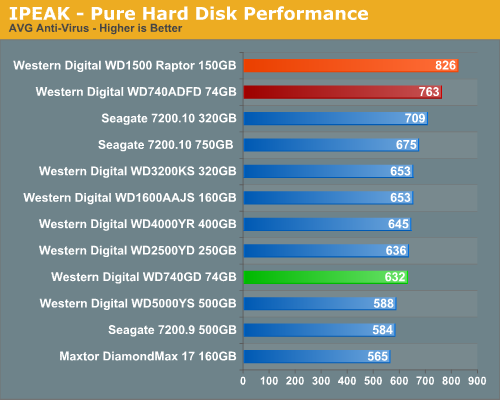

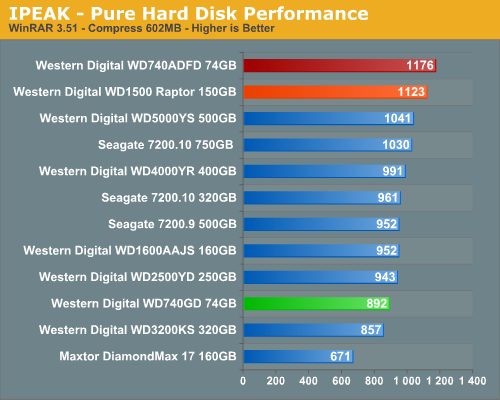
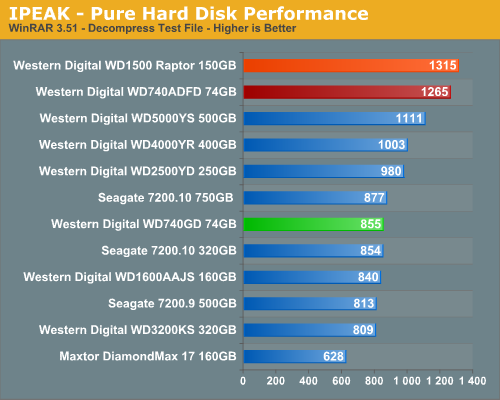
The WD740ADFD slightly trails the WD1500ADFD in our AVG and Defragmentation tests with results that mirror the PCMark 2005 testing. The WD1500ADFD performs better in tests slanted towards read operations while the WD740ADFD performs as well or better in write operations due to slightly better sustained transfer rates. Our WD740GD is unable to keep up with the other Raptor drives - or for that matter several of our other drives that contain the larger 16MB cache sizes. This is especially true in the WinRAR tests where large cache sizes are very advantageous for improved performance.
Our iPeak Winstone benchmarks offer a glimpse into how well our hard disk drives will handle general office applications, media encoding, and graphics manipulation. While the business applications that are being tested tend to be more CPU bound at times, the performance of the hard drive can and will make a difference in the more disk intensive video and graphics applications where large media files are typically being edited.


As expected the WD Raptor drives finish at the top in our business application tests as their 10k RPM spindle speed and optimized cache play an important role in their ability to sustain high transfer rates, especially in the Content Creation benchmark where transfer block sizes are significantly larger and more random than in the Business application benchmark. We see our WD74ADFD finishing ahead of the WD1500ADFD in the Content Creation benchmark where write operations account for a large portion of the test and just barely trailing in the Business Winstone test that emphasizes small block sizes of data in non-sequential order.
iPeak General Task Tests
The iPeak based General Task benchmarks are designed to replicate utility based application tasks that typically are disk intensive and represent common programs utilized on the majority of personal computers. While the WinRAR program is very CPU intensive it will typically stress the storage system in short bursts. Our antivirus benchmark will stress the storage system with continual reads and sporadic write requests while the defragmentation process is split between continual read and write requests.




The WD740ADFD slightly trails the WD1500ADFD in our AVG and Defragmentation tests with results that mirror the PCMark 2005 testing. The WD1500ADFD performs better in tests slanted towards read operations while the WD740ADFD performs as well or better in write operations due to slightly better sustained transfer rates. Our WD740GD is unable to keep up with the other Raptor drives - or for that matter several of our other drives that contain the larger 16MB cache sizes. This is especially true in the WinRAR tests where large cache sizes are very advantageous for improved performance.










26 Comments
View All Comments
Genx87 - Wednesday, February 7, 2007 - link
Once you have one you cant go back :DThey are wonderful drives. The capacity issue isnt a big deal unless you are opting for the 36GB version. I havent had a need for excessive amounts of capacity since I built my sever a couple of years ago.
I built a server with a pair of the 36GBs with a 500GB array behind it for storage. It is a very nice step up from the pair of 80GB 7200 rpm drives in there before.
aka1nas - Wednesday, February 7, 2007 - link
They definately make great OS/Applications drives if you back them up with a bigger drive for bulk storage.Genx87 - Wednesday, February 7, 2007 - link
oops forgot to mention my machine at home has the newest 74GB raptor in it. Which is an upgrade from the 1st run 74GB raptor in my old machine.Blazing fast, as usual.
Muzzy - Wednesday, February 7, 2007 - link
"Of course, if you are into benchmarking or run a lot of disk intensive applications, then a pair of Raptors in RAID 0 will be even better."Um, aren't you guys contradicting yourself here? In July 1st, 2004 article about Raptor drives in RAID-0, you stated "If you haven't gotten the hint by now, we'll spell it out for you: there is no place, and no need for a RAID-0 array on a desktop computer." I love my 150GB Raptor despite the noise, don't get me wrong. Really do wish though that other company would give WD some competition in this category. $190 for 150GB??
JarredWalton - Wednesday, February 7, 2007 - link
Most people don't really care about running benchmarks for bragging rights, and most desktop users do not "run a lot of disk intensive applications". We don't think RAID 0 is even remotely necessary for 99% of people, but there are still benchmarks where it is obviously faster. If you have BitTorrent running in the background with other networked computers streaming data off of the same drive and you start to run games that load off of the same drive, yes, RAID 0 will clearly outperform a single drive. That's more of a server/workstation workload, which is why we say that RAID 0 on a desktop computer isn't needed.Axbattler - Thursday, February 8, 2007 - link
*Ponders*Where RAID-0 excels is in STR performance. Loading of applications that benefit from STR (e.g. XP), copying a large massive file, working with a large massive file (video editing) etc. are applications where you will see a significant gain with RAID-0.
RAID-0 may well be faster than a single drive identical drive in most applications (you do pay slightly in access time, but the gain from STR can probably offset it more often than not).. But how about a well two individual drives in a reasonably configured system? I am not convinced that in the scenario that you've described (which, I do not believe reflects the nature of the workload in a server in the first place), that you are necessarily better off with RAID-0 than two individual drives. I would rather have one drive running the game, and the other doing the streaming/torrenting. Game loading time is not exactly where I've seen RAID-0 shine the most (and once the game is running, you'll pretty much get no gain from RAID-0).
JarredWalton - Thursday, February 8, 2007 - link
Then carry it a bit further. Basically, I'm saying that if you generate enough concurrent HDD accesses, RAID 0 will outperform single drives. You might get better performance from two drives without RAID 0, but then you need to worry about having separate volumes and what happens if most of the accesses start to target a single drive. Basically, RAID 0 can be faster than an individual drive, but this mostly occurs in unrealistic situations, as you point out. RAID 0 mostly seems to be for bragging rights, and I certainly don't recommend it.lemonadesoda - Wednesday, February 7, 2007 - link
Most Raptorers (the people who love and install them) typically choose a dual drive RAID setup for ultimate HDD performance.However, seeing the (very close) performance of Seagate 7200.10, I would be very interested to see Raptors in RAID vs 7200.10 in RAID.
Would the performance gap INCREASE or DECREASE in such a configuration?
Le Québécois - Wednesday, February 7, 2007 - link
It's nice to see my WD1500ADFD is still the top gaming drive on the market. Still something has been bothering me for some time now.I've always found intriguing that my Raptor temperature is about 40% lower (idle and under load) than the one you post on every HDD articles. I have a 80mm Antec front fan but still the temperature is 40% lower, not 25%.
What's the room temperature? You always post the base dB of the room but I don't remember ever seeing the temperature.
jabber - Wednesday, February 7, 2007 - link
Indeed, I bought one of these 74Gb Raptors a few weeks ago and it never gets more than slightly warm. Certainly doesnt warrant an 80mm fan blasting on it.I do recommend the WD Secure SATA cable though. Great bit of kit. How the standard SATA cable connection setup got approved I'll never know.
The niggle I have is that 74Gb is too small? I have a full XP install, several apps and games (BF2/Total War etc. etc. and its still got plenty of space. Why would you bother cluttering up your main system HD with non-essential stuff like media files? Just get a cheap 400Gb+ for that sort of thing where performance isnt an issue.